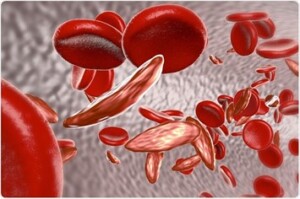Written by A. Hammouda: A recent article in Nature Genetics showed that adenine base editing (ABE) is superior to CRISPR-Cas9 for fetal hemoglobin induction. Cas9 nuclease cuts the DNA at a specific location and introduces random insertions or deletions (indels), while ABE changes a specific base (adenine) to another base (guanine) without cutting the DNA.

Why fetal hemoglobin induction?
Inducing fetal hemoglobin (HbF) in red blood cells can alleviate β-thalassemia and sickle cell disease. Sickle cell disease (SCD) and β-thalassemia are caused by mutations in the HBB gene, which encodes the β-globin subunit of adult hemoglobin (HbA, α2β2). These disorders become symptomatic after birth, following the switch in expression from fetal γ-globin genes (HBG1/HBG2) to mutated β-globin (HBB). Reversing this developmental switch through genetic modification of autologous hematopoietic stem cells (HSCs) represents a promising therapeutic approach.
One way to induce HbF production is by editing the DNA of hematopoietic stem cells (HSCs), which are the cells that give rise to all blood cells. In particular, editing the genes that regulate the expression of HbF, such as BCL11A and HBG, can increase the levels of HbF in red blood cells.
Early clinical studies have demonstrated that suppressing the γ-globin repressor gene BCL11A by Cas9 nuclease-mediated disruption of its erythroid enhancer or RNA interference induces fetal hemoglobin (HbF, α2γ2) and reduces morbidities of SCD or β-thalassemia.
See: Gene Editing for Sickle Cell Disease Succeeded
What did the new study show about fetal hemoglobin induction?
The researchers tested five different editing strategies in human HSCs: Cas9 disruption of the BCL11A erythroid enhancer, which is a DNA sequence that controls the expression of BCL11A in red blood cells; Cas9 disruption of the BCL11A binding motif, which is a DNA sequence that BCL11A binds to in the HBG promoter, which controls the expression of HbF; and ABE installation of three different mutations in the HBG promoter, located –198, –175 and –113 bp upstream of the transcriptional start site, that cause variants of hereditary persistence of fetal hemoglobin (HPFH), a condition where HbF remains high after birth.
The results showed that ABE was more effective than Cas9 in inducing HbF production in red blood cells derived from edited HSCs. Among the ABE strategies, the most potent one was installing the –175A>G mutation, which created a new binding site for TAL1, a transcription factor that activates HBG expression by interacting with another DNA sequence called the locus control region (LCR), a powerful upstream enhancer.
Base editing generated precise nucleotide changes with uniform HbF induction, whereas Cas9 generated indel mixtures with surprisingly variable percentage HbF induction even in cells with disrupted γ-globin promoter BCL11A binding motifs.
Implications of this study
The study demonstrated that base editing represents a potentially superior alternative to Cas9 nuclease for fetal hemoglobin induction and identified a novel mechanism of HbF regulation by TAL1. Diverse indels generated by Cas9 can cause unexpected phenotypic variation that can be circumvented by base editing. These findings have important implications for developing gene editing therapies for SCD and β-thalassemia based on genome editing of HSCs.
See also:
Go to the News Board